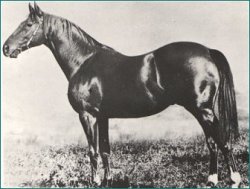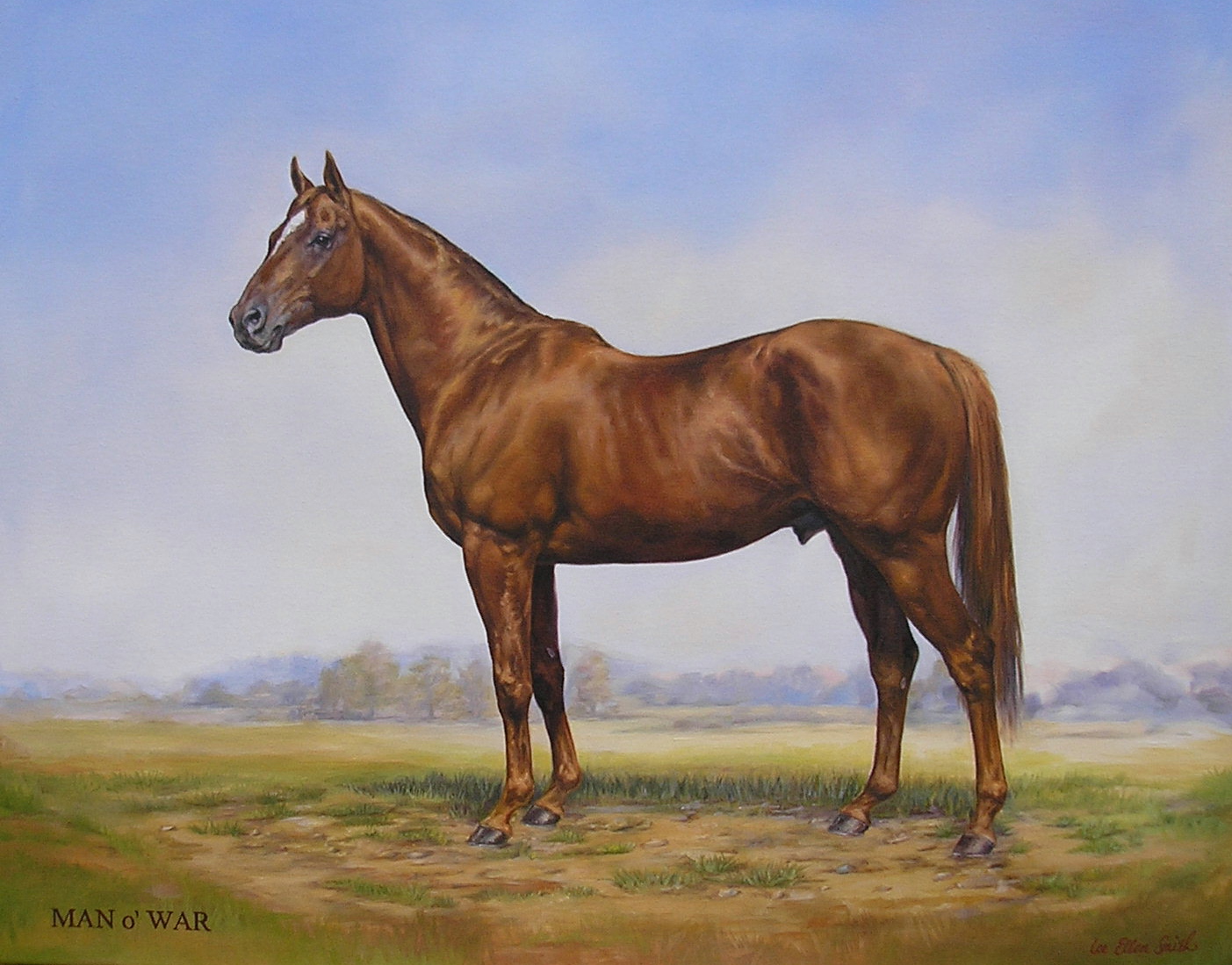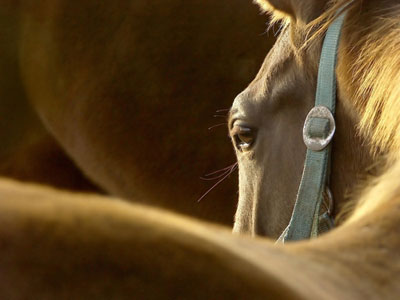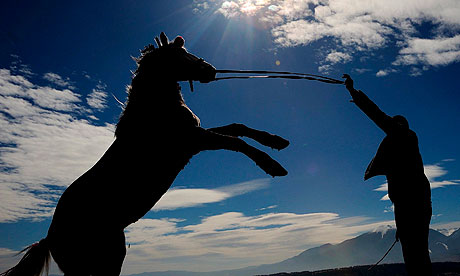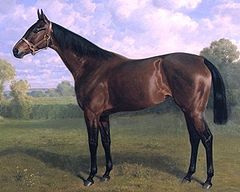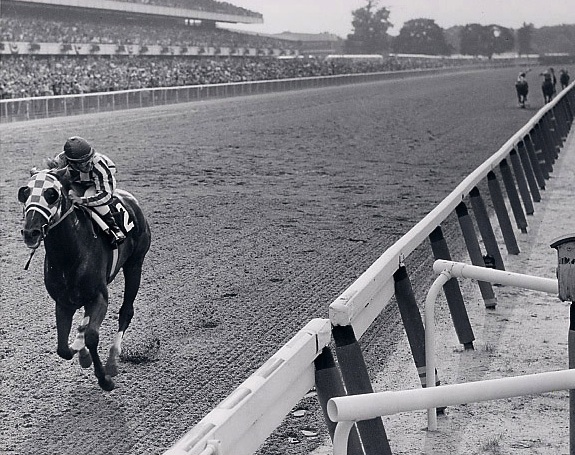
When Secretariat won the 1973 Belmont Stakes by 31 lengths in record time he was catapulted into immortality.
When Secretariat won the 1973 Belmont Stakes by 31 lengths in record time he was catapulted into immortality. There is another horse which raced 120 years ago who ran a race just as incredible as that run by Secretariat in the 1973 Belmont Stakes. The horse is Carbine and the race was the 1890 renewal of the Melbourne Cup run over two miles. Carbine’s victory threw the spectators into a riot of excitement and jubilation-“many people became hysterical in their delight; women shrieked and even wept; and quite decorous old gentleman in frock coats and toppers abandoned their head-gear and shook hands with everyone within reach”.
What brought about this riot of excitement? Carbine had won Australia’s most important race run over 2 miles carrying 145 pounds against a field of 38 competitors by three lengths in record time while giving the 2nd place finisher a 53 pound weight concession. Compare this to Dr. Fager’s immortal race in the 1968 Vosburgh Handicap carrying a 139 pound impost and getting 7 furlongs in 1:20 1/5 and giving the 2nd place finisher 12 pounds.
Why would I bring up this particular race run 124 years ago? It all harkens back to the mission of this web site and my book which is Breeding by Design. All of you who have been in this industry long enough have heard the famous slogan of one of racing’s master horse salesman Leslie Combs of Spendthrift Farms, “Breed the Best to the Best and Hope for the Best”. Sounds great except it hardly ever works, but it does work occasionally. The Blood Horse years ago put out a list of the top selling yearlings from the Saratoga Yearling Sale. The list covered a 50 year period and what it showed was that only two of the highest selling yearlings from this select yearling sale ever earned back their purchase price.
I chose to start this essay with Carbine because he is from one of my favorite families and it illustrates how certain patterns when created lead to classic ability. It doesn’t really matter whether these patterns are the result of planned mating or by accident as long as they occur.
How let’s take a look at Carbine’s pedigree to see what we can learn.
It’s easy to see that the great Carbine is inbred to Brown Bess who is a cluster mare. This particular form of inbreeding is similar to the inbreeding found in The Tetrarch who is inbred to the cluster mare Rouge Rose.
Before we go any further you should know that that Musket the sire of Carbine is the result of breeding a stallion back to his own female line. Both the sire of Musket, Toxophilite and his dam West Australian mare trace to another cluster mare that being Everlasting by Eclipse.
Brown Bess is a cluster mare who has a few other cluster mares tracing to her within a few generations. One is Quiver and another Miss Gunning.
Brown Bess earned cluster mare status by having the following trace to her within 6 generations.
| Horse | Races Won | Generations Back |
| General Peel | 2,000 Guineas | 2 |
| Memoir | Oaks, St Leger | 3 |
| La Fleche | 1,000 Guineas, OaksSt. Leger. Ascot Gold Cup | 3 |
| Ayesha | German Oaks | 5 |
| Straitlace | Oaks | 5 |
| Cinna | 1,000 Guineas | 5 |
| Sunbonnet | Kentucky Oaks, Alabama | 5 |
Brown Bess who required 2 or more winners of 5 classic races within 6 generations to earn cluster mare status, has 7 winners of 12 classics. Just like her granddam, Quiver also earned cluster mare status. The horses that make her a cluster mare follow:
| Horse | Races Won | Generations Back |
| Memoir | Oaks, St. Leger | 1 |
| La Fleche | 1,000 Guineas, Oaks, St. Leger, Ascot Gold Cup | 1 |
| Cinna | 1,000 Guineas | 3 |
| Sunbonnet | Kentucky Oaks, Alabama | 3 |
| Haintonette | Irish Oaks | 4 |
| Uganda | French Oaks, St. Leger | 5 |
| Avestruz | Argentine Oaks | 6 |
| Ukrania | French Oaks | 6 |
| Udaipur | Oaks | 6 |
Not a bad record; 9 winners of 15 classic races. This does not include the non classic winning Polymelus who was five times leading sire in Great Britain in whose pedigree Quiver appears as the granddam.
This brings us to the subject of this essay Miss Gunning who is also a cluster mare. (See why I like this family) Just as Polymelus is a grandson of Quiver, Miss Gunning is a granddaughter of the same mare. The difference is that Miss Gunning is inbred to Brown Bess using the male line to reinforce its own tail female line.
When looking at the pedigree of Miss Gunning one thing becomes very clear, that being, Musket and Quiver are genetic relatives both being sired by Toxophilite and out of daughters of Brown Bess. Since Toxophilite and Brown Bess trace to the same mare this gives Miss Gunning 4 crosses of her tail female line. This is probably what gave her the concentration of classic speed that led to her achieving cluster mare status. The horses that made Miss Gunning a cluster mare are:
| Horse | Races Won | Generations Back |
| Uganda | French Oaks, St. Leger | 3 |
| Ukrania | French Oaks | 4 |
| Udaipur | Oaks | 4 |
| Palestine | 2,000 Guineas | 5 |
| Umiddad | Ascot Gold Cup | 5 |
| Hindostan | Irish Derby | 6 |
| Fiorentina | Irish 1,000 Guineas | 6 |
| Samba | Italian Oaks | 6 |
| Claro | Irish 2,000 Guineas | 6 |
Again we have another cluster mare from this family with the sterling record of 9 winners of 10 classic races within 6 generations.
The following classic pedigrees are further examples of horses inbred to this family using stallions to reinforce the female line.
Poudre a Canon the 3rd dam of German Oaks winner Ayesha
Cinna, 1000 Guineas winner and dam of Beau Pere
Victrix, winner of the French St. Leger. His dam inbred to la Fleche
San Jorge winner of the Argentine Derby, dam inbred to Brown Bess
Avestruz winner of the Argentine Oaks. 3rd dam Lady Spearmint inbred
Udaipur won Oaks inbred to Quiver
Pedigree: Udaipur
If you’d like to see a example of a Miss Gunning descendant in the modern thoroughbred look no further than Wild Again a first class sire and the winner of the first running of the Breeder’s Cup Classic. He traces to Miss Gunning down his tail female line as she is his 8th Dam. Wild Again’s 4th dam is the previously mentioned Udaipur who is inbred to the cluster mare Quiver. Wild Again’s 2nd dam Dama picks up another strain of Quiver through the direct male line of Dante which leads to Polymelus. Wild Again’s sire Icecapade’s male line also leads to Polymelus.
Before I close this essay I’d like to mention what is becoming more apparent with every passing month. That is the use of drugs in American Racing. To show what this has led to over the past 50 years look no further then my favorite racehorse when I was a teenager, Round Table. He started
66 times and won 43 races. Today he would be considered a super horse and a marvel. Round Table carried 130 pounds or more 25 times and won 17 of those races. During a 20 week period in the middle of his three-year-old campaign he started 11 times, averaging one start every two weeks, and won them all. This included 3 races run at 1 ¼ miles, the Hollywood Gold Cup, the Hawthorne Gold Cup, and the American Derby. In the 1st two mentioned races, the Gold cups, he defeated older horses. Is there any such horse living today?
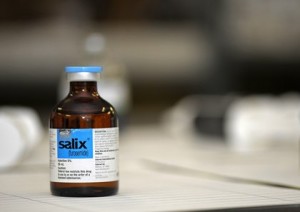
One of the most controversial topics in Thoroughbred racing today is the race-day use of furosemide (commonly called Salix or Lasix).
What seems to be the main culprit?
It would seem to me it’s Lasix. This is a performance enhancing drug! Very few horses are bleeders and yet 94% of the starters in North America are running on Lasix. It is a diuretic which can cause a horse to loose 25 pounds in hours which translates into his carrying 25 less pounds in a race. The problem is that it takes weeks or months for the horse to recover. Is this why the racing jurisdictions are moving the Derby preps further and further back from the first Saturday in May? The Wood Memorial used to be run two weeks before the Kentucky Derby as did the Arkansas Derby and the Blue Grass Stakes, but not anymore. George Strawbridge Jr. the owner of Moonlight Cloud said in an article in the online magazine of the Thoroughbred Daily News that the reason American horses can’t be quickly run back anymore is probably because of Lasix. He said, “The recovery time would not allow it”. Whenever you dehydrate a horse to that extent it is not possible. Look at human athletes, they don’t dehydrate themselves before they race.”
For that matter is that what is causing the decline in the performance of Midnight Hawk. This horse has had more Kentucky Derby preps than any other horse. If he’s running all of these races on Lasix what is the debilitating effects. Unless you’re in the barn with the horse you’ll never know. How do those fans which gambol on horse racing handicap this? How are they supposed to know how long it takes for each individual horse to recover from the effects of Lasix? The answer is there is no way of knowing.
I think it was Bill Oppenheim of The Thoroughbred Daily News who said a few weeks ago that the United States for many years was the domicile for the top commercial stallions. He related that in 2013 of the top 5 commercial Stallions world wide, not one stood in North America.
I hope when the Jockey Club meets in August they find a solution to this problem. We can’t go against the rest of the racing world and come out ahead.






